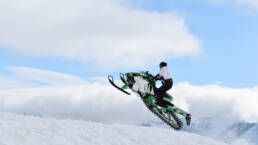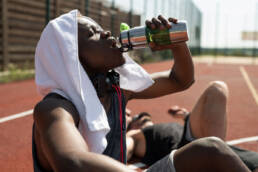Skiing and snowboarding push the body to its limits. Whether you’re carving fresh powder or tackling moguls, your muscles, joints, and connective tissues endure intense strain. For athletes who live for the mountain, an injury isn’t just inconvenient—it’s a roadblock to peak performance and winter enjoyment.
Unlike general fitness issues, skiers and snowboarders often face sport-specific injuries due to repetitive movements, high-impact forces, and unpredictable terrain. Acute overuse problems like knee instability, lower back tightness, or wrist strain require specialized attention. Denver Sports Massage understands that no two injuries are alike. A one-size-fits-all approach won’t cut it when it comes to recovery.
This ultimate recovery plan provides a tailored approach to keeping skiers and snowboarders on the slopes all season long. From injury prevention to personalized recovery techniques, this guide will help you address and overcome snow sport-related challenges so you can keep pushing limits safely.
Common Skiing and Snowboarding Injuries: Understanding the Risks and Recovery
Skiing and snowboarding push the body in different ways, requiring distinct movement patterns, balance techniques, and joint stabilization. While both sports deliver an adrenaline rush and incredible full-body engagement, they also come with unique injury risks. Unlike general athletic injuries, snow sport injuries are often acute and occur due to high-impact falls, overuse, or improper movement mechanics.
Understanding these injuries is the first step in creating an effective recovery plan. By identifying the specific issue, sports massage can be used as a targeted intervention to alleviate pain, restore mobility, and prevent future complications.
Knee Injuries (ACL, MCL, and Meniscus Strains)
Why Skiers Are Prone to Knee Injuries
Skiers rely on lower-body strength, agility, and joint stability to control their speed and movement. However, the twisting forces involved in skiing—especially when making quick directional changes or stopping suddenly—place excessive stress on the knee joint.
- The Anterior Cruciate Ligament (ACL) is one of the most commonly affected areas. A sudden misalignment of the ski, improper landing after a jump, or an awkward fall can overstretch or tear the ACL.
- The Medial Collateral Ligament (MCL) absorbs inward pressure. Skiers who catch an edge or experience an awkward fall may feel a painful strain on the inside of the knee.
- Meniscus injuries occur when the cartilage in the knee is compressed or twisted, often from deep bending or sudden turns.
Common Symptoms
- Pain—especially when twisting or putting weight on the knee
- Swelling and stiffness
- Instability or difficulty standing after impact
- A “popping” sensation at the time of injury
How Sports Massage Helps Knee Recovery
- Reduces muscle tightness in surrounding areas (quads, hamstrings, and calves) to relieve stress on the knee joint
- Improves blood circulation to speed up recovery from strains and minor ligament damage
- Restores proper movement mechanics by easing compensation patterns caused by the injury
Shoulder and Rotator Cuff Strains
Why Snowboarders Are More Prone to Shoulder Injuries
Unlike skiers, snowboarders have their feet fixed to a single board, making falls more impactful on the upper body. When falling, snowboarders instinctively extend their arms to break the impact, which can lead to rotator cuff strains, dislocations, or even collarbone fractures.
- Rotator cuff strains occur when the small stabilizing muscles around the shoulder are overextended or torn.
- Shoulder dislocations can happen if a fall forces the upper arm bone out of its socket.
- AC joint (collarbone) injuries occur when a snowboarder lands directly on their shoulder, pushing the joint beyond its normal range.
Common Symptoms
- Reduced range of motion or stiffness when lifting the arm
- Pain deep in the shoulder joint or around the collarbone
- Weakness when pushing or pulling
- Clicking or grinding sounds with movement
How Sports Massage Helps Shoulder Recovery
- Eases muscle tightness in the shoulders, neck, and upper back to relieve strain
- Encourages proper shoulder movement by addressing imbalances and restoring mobility
- Reduces inflammation and stiffness, making it easier to regain full function
Lower Back Strain and Tightness
Why Both Skiers and Snowboarders Experience Lower Back Issues
The core plays a crucial role in balance, stability, and control when skiing or snowboarding. Whether carving down the slopes or maintaining control over rough terrain, the lower back absorbs a great deal of force.
- Skiers engage their lower back when leaning forward or absorbing shock from bumps and jumps.
- Snowboarders often experience tightness from constant twisting motions and stabilizing their stance.
Common Symptoms
- Aching pain that worsens after a long day on the slopes
- Tightness and stiffness when bending, twisting, or sitting
- Sharp pain with sudden movements
How Sports Massage Helps Lower Back Recovery
- Releases tension in the lumbar spine, hips, and glutes to improve flexibility
- Reduces stiffness by improving circulation and breaking up adhesions
- Restores movement patterns to prevent compensatory stress on other areas
Wrist and Hand Injuries (Sprains and Fractures)
Why Wrist Injuries Are Common in Snowboarding
Unlike skiers, snowboarders don’t have poles to absorb impact, making the wrists the first line of defense during a fall. Extending the hands to brace for impact can result in:
- Wrist sprains (overstretched ligaments)
- Fractures (most commonly the scaphoid bone)
- Thumb injuries from forced hyperextension
Common Symptoms
- Swelling and bruising around the wrist or hand
- Pain when gripping or applying pressure
- Difficulty moving the wrist in certain directions
How Sports Massage Helps Wrist Recovery
- Reduces swelling by promoting lymphatic drainage
- Improves flexibility in the forearm muscles to relieve tension on the wrist
- Aids circulation to promote faster healing of sprained ligaments
Shin and Calf Pain (Shin Splints & Boot-Related Issues)
Why Skiers Experience Shin and Calf Pain
Skiers rely on tight-fitting boots for control and stability, but the constant pressure can lead to shin splints, muscle tightness, and nerve compression.
- Shin splints occur due to repetitive impact and stress on the tibia (shinbone).
- Boot-related pain can result from poorly fitted ski boots or excessive forward pressure on the lower leg.
Common Symptoms
- Throbbing pain along the shinbone, especially after skiing
- Tenderness or swelling in the lower leg
- Numbness or tingling from boot pressure
How Sports Massage Helps Shin and Calf Recovery
- Loosens tight calf muscles, reducing stress on the shinbone
- Improves circulation to reduce pain and prevent chronic irritation
- Helps release fascial tension, making ski boots more comfortable
Key Takeaways: Preventing and Recovering from Skiing & Snowboarding Injuries
While skiing and snowboarding come with inherent risks, targeted recovery strategies can keep athletes performing at their best all winter long. Understanding the specific demands of each sport allows for a personalized recovery approach—one that addresses acute overuse problems, restores movement, and prevents future injuries.
Why Choose Denver Sports Massage?
Denver Sports Massage specializes in sport-specific treatment plans designed for skiers and snowboarders. Instead of offering a generic approach, each session is tailored to the exact muscle groups, movement patterns, and injury concerns of the individual athlete.
Get Back on the Slopes—Pain-Free
Don’t let an injury cut your season short. If you’re experiencing pain, stiffness, or mobility issues from skiing or snowboarding, a customized sports massage plan can help you recover faster and stay strong all winter long.
Ready to take control of your recovery? Book a session with Denver Sports Massage and get back to doing what you love—carving fresh powder and conquering the slopes.
The Ultimate Recovery Plan for Skiers & Snowboarders
A strong recovery strategy ensures that injuries heal properly while reducing the risk of future problems. Here’s how Denver Sports Massage helps athletes return to peak condition with a tailored approach:
Identifying the Root Cause
Skiers and snowboarders often experience acute overuse injuries due to specific movement patterns and repetitive stress. A professional sports massage therapist examines movement restrictions, muscle imbalances, and overworked areas to create a personalized recovery plan.
Reducing Inflammation and Pain
- Myofascial release: Loosens tight connective tissue to relieve tension.
- Trigger point therapy: Targets localized pain points to promote healing.
- Lymphatic drainage massage: Reduces swelling and improves circulation.
Restoring Mobility and Flexibility
- Active stretching techniques increase joint range of motion.
- Soft tissue mobilization helps muscles recover without excessive strain.
- Deep tissue massage breaks down adhesions that limit flexibility.
Strengthening Weak Muscles
- Releasing tight muscles helps prevent compensatory movement patterns.
- Strength and stability work ensures long-term durability.
- Core activation techniques improve posture and spinal stability.
Preparing the Body for the Next Run
- Sports-specific massage optimizes muscle function for performance.
- Pre-ski/snowboard warm-up massage increases circulation and muscle activation.
- Post-session recovery massage flushes out lactic acid and prevents soreness.
Preventative Strategies to Avoid Ski and Snowboard Injuries
While recovery is crucial, preventing injuries in the first place is even better. Skiers and snowboarders can adopt these strategies to stay strong all winter.
Strength and Stability Training
- Focus on leg strength, balance, and core stability to reduce knee and back strain.
- Single-leg exercises like Bulgarian split squats and step-ups mimic skiing mechanics.
- Rotational core exercises help with carving movements and turns.
Proper Warm-Up and Cool-Down
- Dynamic stretches before hitting the slopes improve blood flow and muscle activation.
- Cooldown stretching prevents stiffness and aids recovery.
- Denver Sports Massage offers pre-activity warm-up massage sessions to enhance flexibility.
Equipment Check
- Ski boots and bindings should be professionally fitted to prevent excessive knee and ankle strain.
- Snowboard stance adjustments can reduce lower back stress.
Listen to Your Body
- If you feel tightness or discomfort, seek treatment before it becomes a bigger issue.
- Denver Sports Massage specializes in addressing acute overuse problems before they lead to more significant injuries.
Why Choose Denver Sports Massage for Ski and Snowboard Recovery?
Sport-Specific Focus
Unlike generic massage approaches, Denver Sports Massage tailors treatment to your exact snow sport injury. Whether it’s a strained ACL from skiing or a wrist sprain from snowboarding, the treatment plan is designed for your sport’s unique demands.
Hands-On Recovery Without the One-Size-Fits-All Approach
Instead of generalized treatments, each session focuses on:
- The specific muscles and joints impacted by skiing and snowboarding
- Identifying movement restrictions and muscle imbalances
- Providing targeted relief through sports-specific techniques
Trusted by Athletes & Weekend Warriors Alike
Whether you’re an experienced ski instructor or a weekend warrior, the goal is the same—get back on the slopes without pain or limitations.
Conclusion: Stay Strong, Stay on the Slopes
The mountains are calling, and whether you’re carving down double black diamonds or enjoying a leisurely ride through fresh powder, the last thing you want is to be sidelined by an injury. Skiing and snowboarding push your body in unique ways, and when injuries occur, they’re rarely random—they’re sport-specific and movement-driven. A tight lower back, an overstressed knee, or a sore shoulder isn’t just discomfort—it’s your body signaling that something needs attention before it worsens.
Ignoring pain or trying to “power through” can lead to longer recovery times, decreased performance, and potentially a full season lost to injury. But with the right recovery plan, you don’t have to sit out. You can heal, rebuild, and come back even stronger.
Denver Sports Massage: Your Partner in Recovery & Performance
Denver Sports Massage isn’t just about relaxation—it’s about helping serious skiers and snowboarders stay in peak condition. Whether you’re dealing with:
- Knee instability from skiing’s high-impact twists and turns
- Shoulder or wrist pain from snowboarding falls
- Chronic lower back tightness from hours of carving
- Shin pain from boot pressure and overuse
You need a recovery plan that targets the exact root of the problem. A generic massage won’t cut it. That’s why Denver Sports Massage customizes every session based on your sport, injury type, movement mechanics, and recovery goals.
What Sets Denver Sports Massage Apart?
- Sport-Specific Focus: Techniques designed for skiers and snowboarders—not just general recovery.
- Injury-Specific Approach: No one-size-fits-all treatments—each session is based on your individual needs.
- Acute Overuse Recovery: Targeting the specific muscle groups and movement patterns causing the problem.
- Performance Optimization: Helping you return to the slopes stronger, more mobile, and pain-free.
Don’t Let an Injury Cut Your Season Short
You invest in the right gear, proper training, and time on the mountain—so why wouldn’t you invest in your body’s recovery and performance? Staying injury-free isn’t just about healing when something goes wrong; it’s about proactive care that keeps you strong and resilient all season long.
Take Control of Your Recovery Today
- Feeling the strain from long days on the mountain?
- Struggling with a nagging injury that’s slowing you down?
- Want to optimize your recovery and prevent future issues?
Book a sports massage session with Denver Sports Massage today and get back to doing what you love—carving fresh powder and conquering the slopes with confidence.

With unique treatment plans tailored specifically to each individual, our goal is to offer a comprehensive approach to healing and reducing pain. We pride ourselves on taking a holistic approach to massage therapy for pain and are committed to providing the highest quality care. If you’re looking for a massage therapist in Denver to help with pain, schedule an appointment today!
Like this article? Spread the word!
Related Posts
April 15, 2025
Weekend Warriors, Beware: How to Bounce Back From Spring Sports Injuries
Weekend warriors, beware—spring injuries can sneak up fast. Learn how massage therapy…
March 15, 2025
Ski & Snow Sports: Addressing Muscle Tightness and Fatigue, Injury Prevention, and the Benefits of Massage Therapy
Relieve muscle tightness and fatigue from skiing with massage therapy. Learn injury…
January 15, 2025
Your Secret Weapon for Sticking to New Year’s Resolutions: Sports Massage for a Strong Start
Discover how Denver Sports Massage can help you stick to your New Year’s resolutions.…





